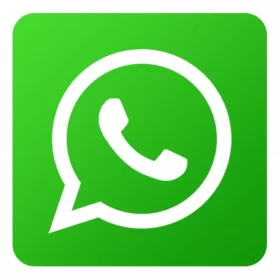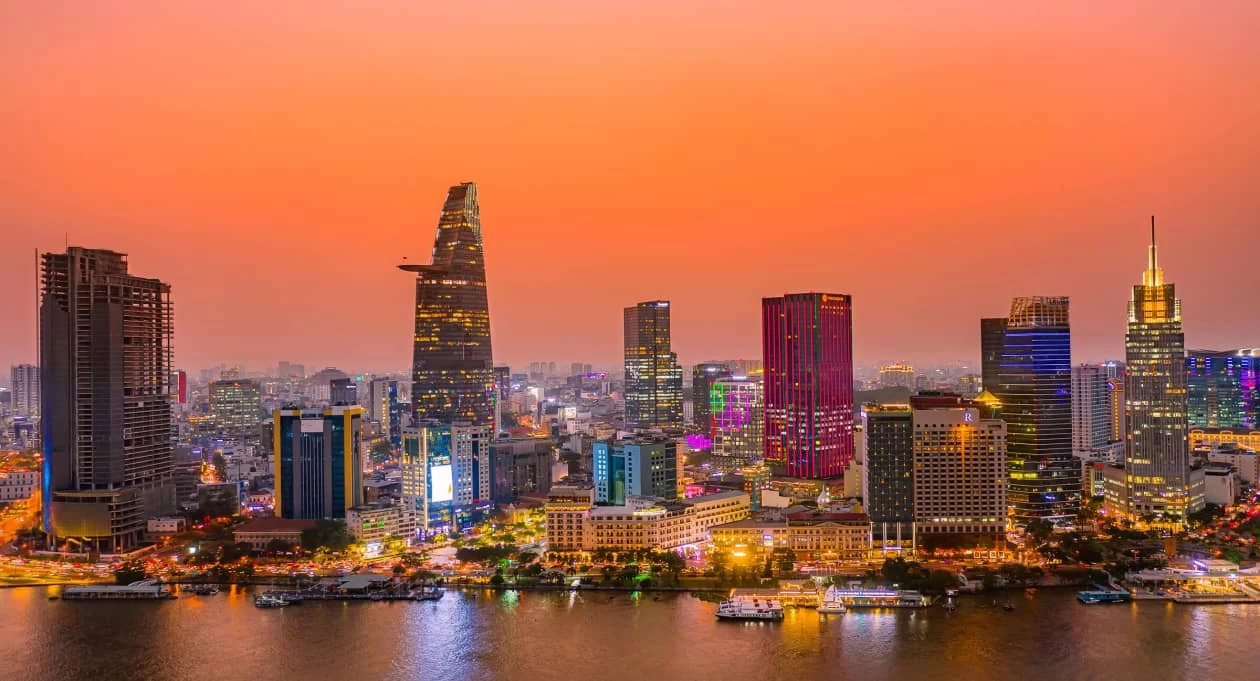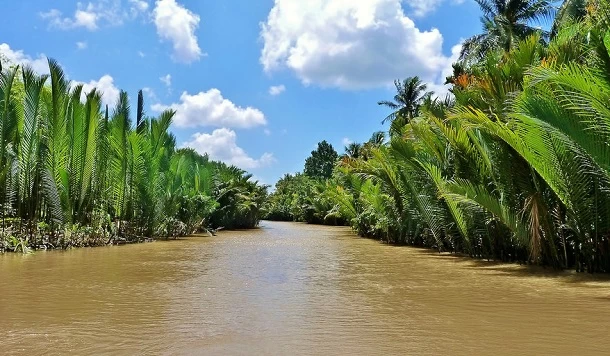
Let’s explore Mekong Delta with Ula Travel!
Tourism in the Mekong Delta evokes nostalgia for many travelers with its serene beauty, carrying a unique vitality of its own. Not only does it showcase rich natural beauty, but the Mekong Delta is also a convergence of historical values with a plethora of distinctive cultural elements.
Exploring the Mekong Delta, visitors are captivated by the picturesque simplicity of daily life, filled with the vibrant essence of cheerful existence, characterized by thick clusters of water hyacinths, weaving through the lively “dances” of nature’s allure. This is why tourists flock to this area in large numbers throughout the year.
I. Introduction to Mekong Delta
1. Where is Mekong Delta?
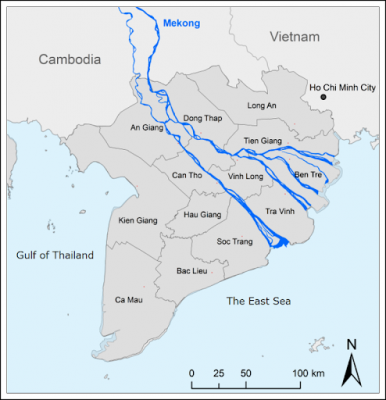
Map of Vietnamese Mekong Delta
The geographical location and natural conditions of the Mekong Delta play a significant role in the exploitation and development of its economy as well as culture. Thanks to these natural conditions, the Mekong Delta has thrived in food processing and tourism, contributing significantly to the country’s economy.
Situated in the Southern Vietnam, bordering the western region of the Southeast region, the area encompasses numerous islands and islets, with a coastline stretching 73.2km. This geographical location is highly favorable for economic development, especially in cultivating industrial crops such as rice, sugarcane, coffee, rubber, and various fruits.
2. How to Get to Mekong Delta
Traveling to the Mekong Delta from Ho Chi Minh City or neighboring provinces such as Dong Nai, Binh Phuoc, Binh Duong, or Vung Tau, offers various transportation options, including motorcycles, self-driving cars, and buses, as the distances are not considerable.
Opting for buses, you simply need to purchase tickets for your desired route to the provinces in the Mekong Delta. Nowadays, hundreds of bus trips commute daily from Ho Chi Minh City to the Mekong Delta provinces, making it convenient to buy tickets and choose suitable travel times. Correspondingly, the bus schedules are quite flexible, operating from 3:00 am to 12:00 am daily.
3. Best Time to Visit the Mekong Delta
The Mekong Delta offers distinct experiences across its two primary seasons: the dry season, from December to April, and the wet season, from May to November. Each season provides unique opportunities for travelers to explore the region, with different weather patterns and seasonal activities to enjoy.
- Dry Season (December to April): This is generally considered the best time to visit the Mekong Delta due to its mild and pleasant weather. During these months, temperatures range from 25°C to 33°C (77°F to 91°F), with low humidity and minimal rainfall. The drier climate makes it ideal for outdoor activities, sightseeing, and boat tours.
- Wet Season (May to November): During the wet season, the Mekong Delta experiences regular rainfall, with temperatures ranging from 24°C to 32°C (75°F to 90°F). Although it rains frequently, showers are often short and followed by clear skies. The rains bring a lush, green landscape, and the Mekong River reaches its highest levels, nourishing the land and supporting abundant agriculture.
Discover now: Mekong Delta Tours
II. Culture of Mekong Delta
With a population of over 17 million people, the Mekong Delta is a melting pot of cultures from four main ethnic communities: Vietnamese culture of the Kinh people, Indian culture of the Khmer of Southern Vietnam, Chinese culture of the Hoa people, and Islamic culture of the Cham people. This diversity contributes to a plethora of religious beliefs, valuable architectural ensembles, and unique traditional craft villages.
1. Floating Markets in the Mekong Delta
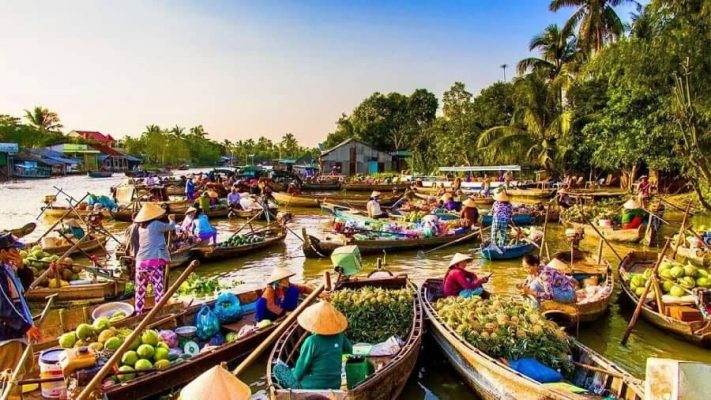
Floating Markets in the Mekong Delta
Arising from the need for trading goods among the people of the riverine regions, the floating markets in the Mekong Delta are now not only places for trading goods and agricultural products but also distinctive cultural features, impressive tourist products that need to be maintained and developed for sustainable growth.
Visiting the floating markets in the Mekong Delta, many feel as if they are witnessing a vibrant, colorful canvas of life. Immersing oneself in the atmosphere of trading goods on the water, one gains a deeper understanding of the distinctive culture of the people in the southern delta region of the country.
Learn more about: Mekong Delta Culture – Experience Authentic Life
2. Diverse and abundant culinary culture
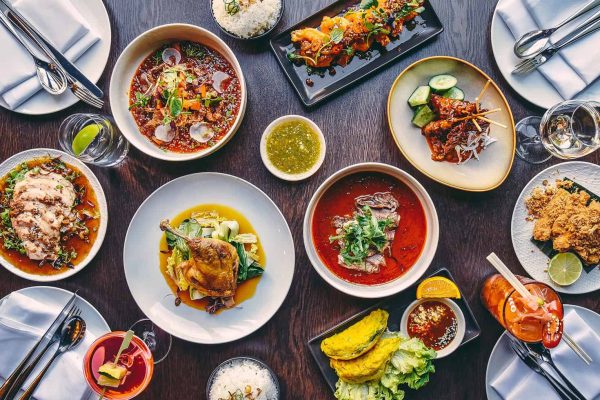
The culinary of the Mekong Delta
The culinary culture of the Mekong Delta is diverse, rich, and unique, distinct from any other region. Notably, unique dishes here include grilled snakehead fish or hotpot made from fermented fish, renowned fried coconut worm, as well as rustic dishes with the rich flavors of the river such as sour soup with linh fish cooked with điên điển flower buds,…
Click here: Mekong Delta Tour Package
III. Mekong Delta Attractions
1. Tan Lap Floating Village Eco-Tourism Area, Long An
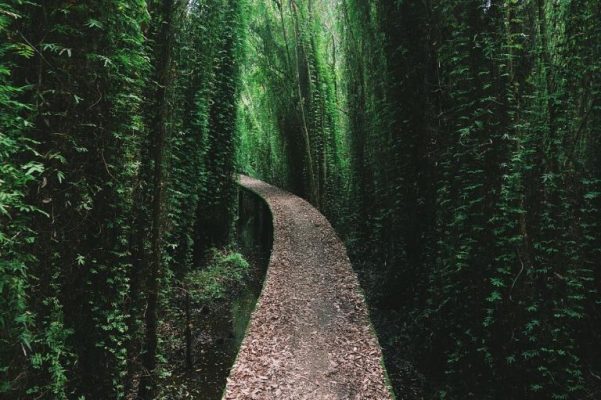
Tan Lap Floating Village
Tan Lap Floating Village, located in Moc Hoa district, Long An province, is cherished by many as their first destination. It can be described as a tourist spot that owes its popularity to favorable weather, terrain, and welcoming locals.
In its natural state, Tan Lap Floating Village spans 135 hectares, adorned with melaleuca forest vegetation. Due to its convenient location, reaching this destination is quite easy, with various transportation options available such as motorcycles, tourist cars, and Grab Bike.
Star your journey with: Best of Southern Vietnam
2. Con Phung Tourist Area, Ben Tre
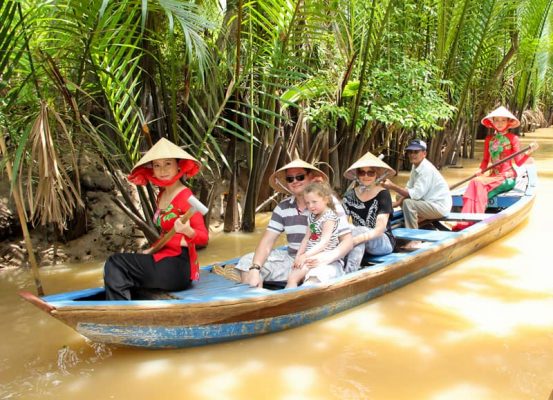
Con Phung Tourist Area, Ben Tre
Con Phung stands out as a renowned tourist destination in Ben Tre, situated within the “four sacred” island complex comprising Long, Lan, Qui, and Phung. It is approximately a 2-hour drive from Ho Chi Minh City.
Visitors to Con Phung can engage in a variety of unique activities, including cycling on the monkey bridge, swinging across the river, crocodile fishing, and bottle-feeding fish.
3. Cai Rang Floating Market, Can Tho
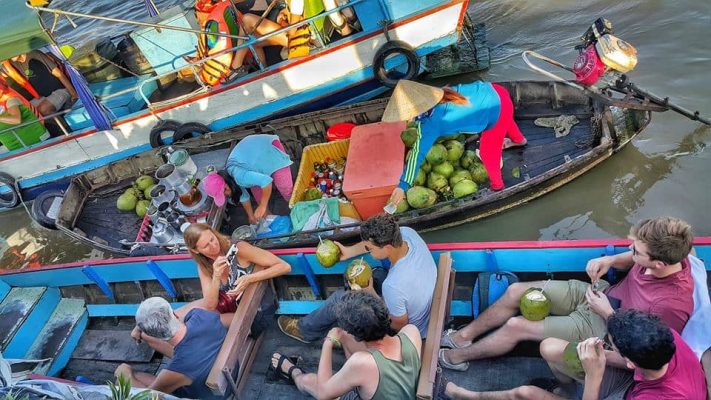
Cai Rang Floating Market
Cai Rang Floating Market holds a significant place on the Vietnamese tourism map, often featured in renowned travel magazines as a must-visit destination in the West. Its charm captivates visitors, compelling them to at least capture a photograph to treasure. Over the years, the number of Western tourists visiting this market has surpassed that of local visitors.
You will be like: Discover The Ho Chi Minh City to Mekong Delta Tour
4. Cai Be Floating Market
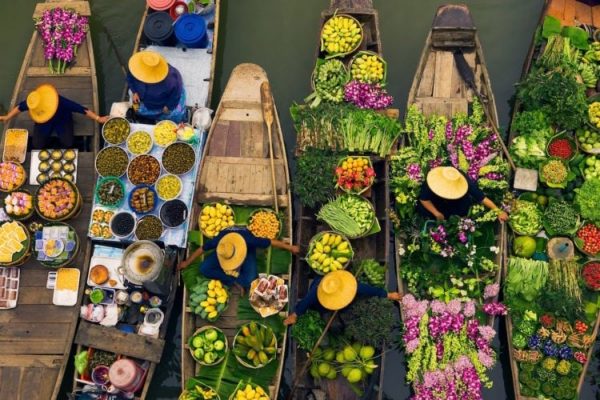
Cai Be Floating Market
Cai Be Floating Market stands as one of the largest retail markets in the Mekong Delta, nestled in Cai Be town, Tien Giang province. Beyond offering fresh fruits and vegetables, the market is a hub for fabrics, household items, and fresh seafood, with food and beverages served directly from boat to boat.
Do not miss: Discover A Glimpse of The Mekong Delta 2D1N
5. Phong Dien Garden, Can Tho
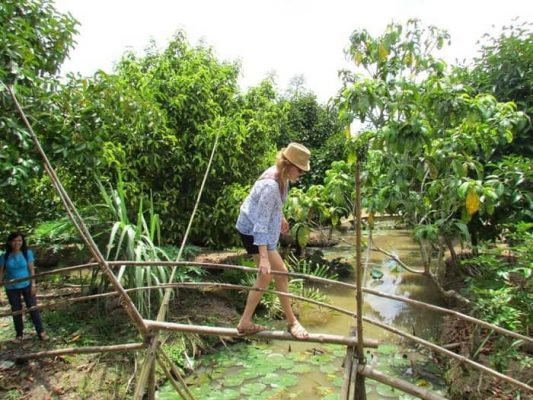
Phong Dien Garden
Travelers flock to Phong Dien Garden to indulge in its bountiful fruit orchards. Although this year’s harvest is slightly affected by drought, visitors can still relish in Western specialties and partake in local pastimes such as fish-catching in ditches, rowing boats, and crossing monkey bridges.
6. Chau Doc Market, An Giang
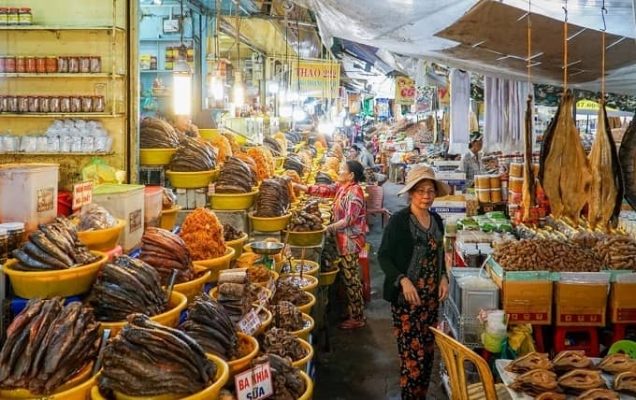
Chau Doc Market
Chau Doc boasts a rich cultural blend of Cham, Khmer, Kinh, and Chinese influences, with its culinary scene renowned for fish sauce. The market, known as the “kingdom of fish sauce and dried fish,” offers an array of products made from local fish, including fish sauce, dried fish, and snakehead fish.
Additionally, visitors can savor various specialties such as fish vermicelli, num-bo-hok vermicelli, palm juice, beef cakes, and Nam Vang noodles, all at affordable prices.
7. Tra Su Melaleuca Forest, An Giang
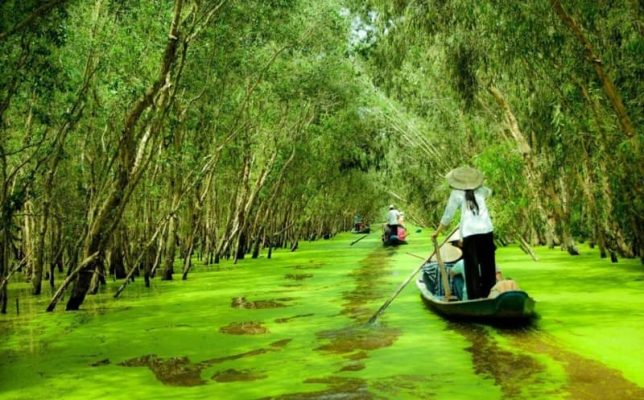
Tra Su Melaleuca Forest
Tra Su Melaleuca Forest in An Giang shines as one of Vietnam’s tourism gems. However, the forest may experience low water levels in 2020 due to drought. Exploring Tra Su Melaleuca Forest when water levels are low might not offer the full experience. Situated approximately 20 km from Chau Doc, this vast and enchanting Melaleuca forest features a canopy of lush green leaves above and a carpet of duckweed beneath the water’s surface.
Visitors arriving between 7:00 a.m. and 9:00 a.m. can witness various bird species foraging and gathering throughout the forest, with some birds even flying close to observers. Alternatively, those arriving between 4:00 p.m. and 6:00 p.m. can ascend to the observation deck to witness flocks of birds returning to their nests on tall trees as dusk sets in.
IV. Top Activities for Tourists in the Mekong Delta
1. Boat Tours
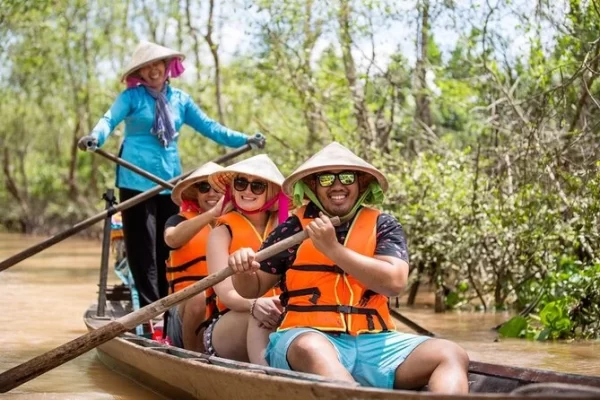
Boat Tours on the Mekong Delta
Exploring the Mekong Delta by boat is one of the most immersive and popular ways to experience this unique region. Tourists can choose from a variety of boats and river cruises tailored to different tastes and schedules:
- Traditional Sampan Boat Tours: These small wooden boats allow travelers to venture deep into the winding canals and narrow waterways, passing by local homes, coconut groves, and mangrove forests. A sampan tour provides a close-up look at daily life along the riverbanks and is perfect for those seeking an authentic and tranquil experience.
- Luxury River Cruises: For a more comfortable journey, luxury river cruises offer spacious, well-equipped boats with onboard dining and amenities. These cruises typically cover a larger area, stopping at floating markets, villages, and cultural sites. Many luxury cruises offer overnight stays, allowing guests to enjoy beautiful sunsets and sunrises over the river.
- Sunset and Sunrise Cruises: Early morning and late afternoon cruises are ideal for watching the delta’s breathtaking sunrises and sunsets. These tours often include visits to floating markets or stops along local fishing spots, providing excellent photo opportunities and a peaceful ambiance.
Exploring the delta’s waterways not only offers stunning views of lush landscapes but also provides insight into the local economy, which relies heavily on fishing, farming, and river trade.
2. Cycling Through Villages in Mekong Delta
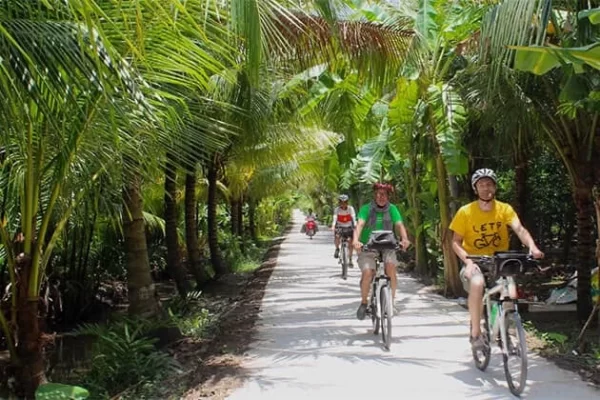
Cycling Through Villages in Mekong Delta
Cycling through the Mekong Delta’s villages offers a peaceful, scenic way to experience the rural charm of the area. With flat terrain and quiet paths, the delta is well-suited to leisurely bike rides that take tourists off the beaten path.
- Village Paths and Rice Fields: Biking along narrow village roads, travelers can pass through vast rice paddies and see farmers working in the fields. This route is also dotted with traditional stilt houses, friendly locals, and beautiful lotus ponds, making it a perfect way to capture the essence of rural Vietnam.
- Fruit Orchards and Coconut Plantations: The Mekong Delta is known for its abundant fruit farms and coconut groves. Many bike tours include stops at local orchards where visitors can sample fresh fruits like rambutan, mango, and durian, as well as enjoy refreshing coconut water straight from the source. Some farms also invite guests to learn about fruit cultivation and harvesting.
Cycling through these serene landscapes gives tourists the chance to see the delta at a slower pace, interact with locals, and observe daily life in this peaceful region.
3. Local Cuisine and Cooking Classes
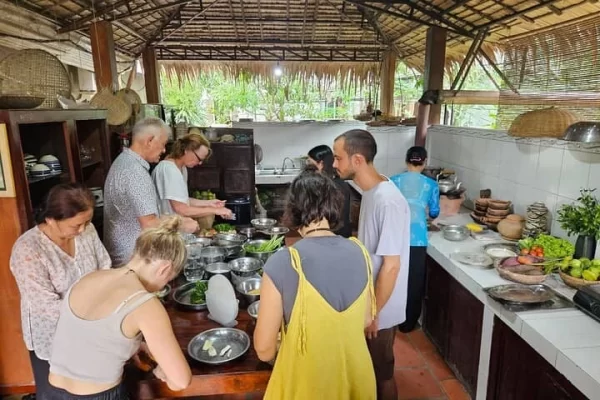
Visitors can take cooking classes to experience the culture.
The Mekong Delta is renowned for its diverse and flavorful cuisine, influenced by the region’s rivers, farmlands, and cultural diversity. Visitors can explore the local flavors through food tours and hands-on cooking classes.
- Signature Dishes: Some must-try dishes in the Mekong Delta include:
- Cá Lóc Nướng Trui: A traditional grilled snakehead fish dish, often cooked over an open flame and served with rice paper, fresh herbs, and dipping sauce.
- Lau Mam: A rich, fermented fish hot pot featuring a variety of vegetables, meats, and local seafood. This dish is a favorite among locals for its hearty and savory flavors.
- Bún Nước Lèo: A unique noodle soup with a robust broth, typically made with fish or shrimp paste and accompanied by fresh herbs and vegetables.
- Cooking Classes with Locals: Many villages offer cooking classes where visitors can learn how to prepare traditional dishes from local chefs. These classes usually start with a trip to a local market to select fresh ingredients, followed by a step-by-step cooking session. Participants can try their hand at creating regional specialties, gaining insights into Vietnamese cooking techniques and ingredients.
V. Wildlife and Nature Reserves in the Mekong Delta
1. Tram Chim National Park
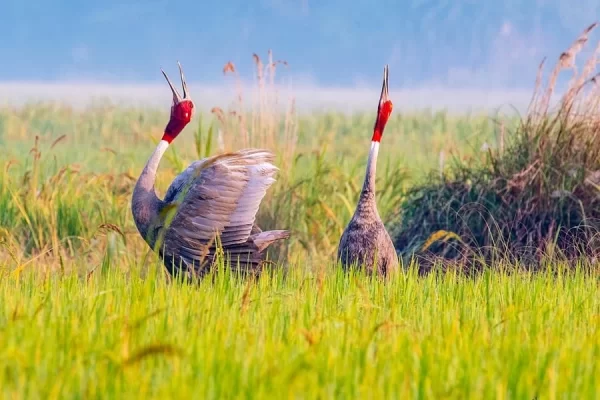
Tram Chim National Park has many rare animals.
Tram Chim National Park, located in the Dong Thap Province, is one of the most important protected areas in the Mekong Delta. Covering an area of over 7,000 hectares, this park is a haven for biodiversity, particularly for birdwatchers. The park is renowned for its thriving ecosystem of wetlands, freshwater swamps, and grasslands, creating the ideal environment for various species to thrive.
2. U Minh Ha and U Minh Thuong Forests
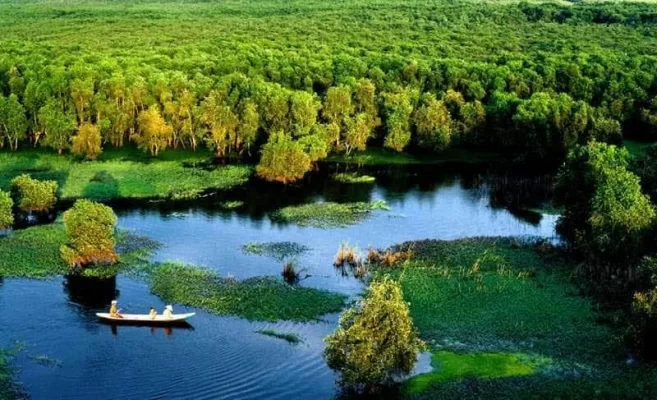
The pristine beauty of U Minh Ha National Park
U Minh Ha and U Minh Thuong are two interconnected national parks located in the southern part of the Mekong Delta, known for their vast areas of mangrove forests and peat swamp ecosystems. These forests are crucial to maintaining the ecological balance of the delta and are home to many rare and endangered species.
- U Minh Ha National Park: Situated in Ca Mau Province, U Minh Ha is a vast area of mangrove forests, offering visitors an opportunity to explore an ecosystem teeming with life. The park is home to various species of birds, reptiles, and amphibians, and it serves as a vital area for biodiversity.
- U Minh Thuong National Park: Located in Kien Giang Province, this park is famous for its peat swamp ecosystems, which are rich in plant and animal life. The area’s wetlands are crucial for maintaining the region’s hydrological systems and for providing a home to species such as wild boar, squirrels, and crocodiles.
3. Bird Watching and Eco-tours
The Mekong Delta is a birdwatcher’s paradise, with its wide array of habitats attracting both local and migratory birds throughout the year. From the vast wetlands of Tràm Chim to the mangrove forests of U Minh, there are plenty of opportunities to explore the region’s birdlife in their natural habitat.
- Bird-Watching Tours: Many local tour operators offer specialized bird-watching tours to explore the Mekong Delta’s various wildlife reserves. Visitors can observe hundreds of species, including waterfowl, herons, egrets, and the rare sarus crane. The best times for bird watching are during the migratory seasons (October to April), when thousands of birds flock to the region from northern Asia.
- Eco-tours: Eco-tourism has become a growing industry in the Mekong Delta, with more and more travelers opting for sustainable tours that focus on preserving the environment while offering an authentic experience. Eco-tours typically include visits to nature reserves, cycling through rural villages, kayaking through mangrove forests, and even participating in conservation efforts such as tree planting or wildlife monitoring.
In conclusion, Mekong Delta is a must-visit destination for international travelers looking to explore Vietnam’s unique culture, nature, and way of life. With its stunning landscapes, vibrant floating markets, and rich traditions, the region offers an unforgettable experience that combines adventure, relaxation, and cultural immersion. A visit here will leave you with lasting memories of this extraordinary part of Southeast Asia.
See more: Mekong Delta travel tips

